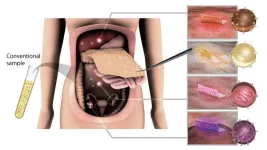(Press-News.org) Silicon (Si) is abundant in terrestrial environments and accounts for 0.1% to 10% of a plant’s dry weight. Certain plant species show high levels of Si accumulation, and research has identified high Si accumulation as a protective mechanism against abiotic (drought, cold, heat) and biotic stressors (living organisms). Oryza sativa (rice) can store Si to the tune of 10% of the dry weight of shoots (stem, leaves, flowers), and Si is vital for stable grain production. High degree of Si deposition is believed to mitigate against damage caused by pests, pathogens, and nutrient imbalances. In rice, Si uptake is governed by two different types of root transporters, but the specific machinery involved in cell-specific Si deposition in rice leaves remains a mystery.
Researchers at Okayama University, Japan, have found that the Silicon Efflux Transporter 4 (SIET4) facilitates the localization of Si in rice leaves. Their functional analyses detailing the effects of SIET4 deletion mutants were published in Nature Communications on October 19, 2023. The project was led by Dr. Jian Feng Ma, a Professor at the Institute of Plant Science and Resources at Okayama University. The report was co-authored by Dr. Namiki Mitani-Ueno, Dr. Naoki Yamaji, Dr. Sheng Huang, and Dr. Takaaki Miyaji, also from Okayama University. “My research group has been probing the molecular mechanisms that underpin rice’s capacity to accumulate high Si for a while now,” says Dr. Ma. He further adds, “However, while we had identified the transporters that enable the uptake by the roots and root-to-shoot translocation of Si, we were yet to determine how Si was deposited in the leaves.”
The team utilized an array of experiments to understand the role of SIET4 in leaf Si accumulation. These included generating knockout mutants—where a target gene is destroyed—and the functional characterization of SIET4 to compare the transcription profiles of wild-type (WT) rice and SIET4 mutants. The team also profiled the transport activity and cellular localization of SIET4. “We confirmed that SIET4 encoded a Si transporter and was constitutively expressed in WT rice leaves. Moreover, the transporter was confined to the distal side of epidermal and bulliform cells (assist in rolling of leaves to avoid water loss) of the leaf blade,” says Dr. Ma. Unlike WT rice, plants that lacked SIET4 displayed inhibited growth and eventually died when grown in the presence of Si in nutrient solution and soil. Other characteristic features of the SIET4 mutants were diminished roots and shoots, abnormal Si deposition in leaf mesophyll cells, and the induction of many stress response genes. This finding indicates that the improper accumulation of Si in undesignated tissue was akin to the plant responding toward an environmental stressor. Taken together, the team’s data pointed to SIET4 being vital to the proper export of Si from leaf cells to the leaf surface and for the healthy growth of the plant.
This presents a paradigm shift as it was long believed that Si was the only element found in such abundance in the soil that did not damage a plant. In the case of rice, these findings show that intricate processes like earmarking Si accumulation for the leaf ensure survival. The report represents 10 years of research coming to fruition, but Dr. Ma is steadfast in his resolve. He concludes, “This work has the potential to broaden our understanding of how plants accumulate high Si. We hope to find genes like SIET4 in other plant species so we can address improving the productivity of many more important crops.”
About Okayama University, Japan
As one of the leading universities in Japan, Okayama University aims to create and establish a new paradigm for the sustainable development of the world. Okayama University offers a wide range of academic fields, which become the basis of the integrated graduate schools. This not only allows us to conduct the most advanced and up-to-date research, but also provides an enriching educational experience.
Website: https://www.okayama-u.ac.jp/index_e.html
About Professor Jian Feng Ma from Okayama University, Japan
Dr. Jian Feng Ma is a Professor at the Institute of Plant Science and Resources (IPSR) at Okayama University, Japan. He earned his Ph.D. in Plant Nutrition from Kyoto University in 1991 and became a professor at the IPSR in 2005. He researches the transporters plants use for essential, beneficial, and toxic mineral elements and conducts extensive research on rice. Prof. Ma was identified as the most-cited researcher from 2015 to 2022 and has published over 300 peer-reviewed articles since 1989. He received the Japan Prize of Agricultural Science, the Yomiuri Prize for Agricultural Science in 2019, and national medal with purple ribbon in 2022.
END
Identifying a silicon transporter to improve the yield of rice
Researchers identify a membrane transporter in rice that regulates the accumulation and localization of silicon in the leaves
2023-11-08
ELSE PRESS RELEASES FROM THIS DATE:
The American Pediatric Society selects Dr. Glenn Flores as the recipient of the 2024 David G. Nichols Health Equity Award
2023-11-08
The American Pediatric Society (APS) is pleased to announce Glenn Flores, MD, as the 2024 David G. Nichols Health Equity Award recipient.
The David G. Nichols Health Equity Award, administered by the APS and endowed by the American Board of Pediatrics (ABP) Foundation, was created to recognize demonstrated excellence in advancing child and adolescent health, well-being, and equity through quality improvement, advocacy, practice, or research. This award recognizes Dr. Flores’ outstanding contributions to advancing child and adolescent health, well-being, and equity and the ...
Device 'smells' seawater to discover, detect novel molecules
2023-11-08
Under the ocean’s surface, marine organisms are constantly releasing invisible molecules. Some of the chemical clues reveal which creatures are nearby, while others could be used someday as medications. Now, researchers in ACS Central Science report a proof-of-concept device that “sniffs” seawater, trapping dissolved compounds for analyses. The team showed that the system could easily concentrate molecules that are present in underwater caves and holds promise for drug discovery in fragile ecosystems, including coral reefs.
A ...
A step to prevent opioid overdose deaths with light-activated naloxone treatment
2023-11-08
By rapidly reversing the effects of an opioid overdose, naloxone saves lives ― if it’s available at the right time. To eliminate this element of chance, researchers are exploring ways to have the medication available in the body before it’s needed. In a proof-of-concept in ACS’ Nano Letters, a team has designed injectable nanoparticles that released naloxone when triggered by blue light. In experiments with mice, this system was activated a month after injection.
Since it began more than two decades ago, the opioid epidemic has taken an enormous toll on people’s lives. In 2022 ...
Systemic sclerosis-associated interstitial lung disease focus of latest clinical practice guideline
2023-11-08
In patients with systemic sclerosis (SSc), a rare connective tissue disease, interstitial lung disease contributes to 35 percent of deaths. Published recently in the American Journal of Respiratory and Critical Care Medicine, the latest American Thoracic Society Clinical Practice Guideline makes a number of recommendations. One recommendation expands antifibrotic treatment to all patients with systemic sclerosis associated with ILD (SSc-ILD), not just those with progressive disease.
Watch the explainer video.
Lead guidelines chair and editor, Ganesh Raghu, M.D., ATSF, noted the timeliness of the recommendations given the many immune ...
Study confirms the use of a new biomarker for predicting non-lymphocytic lesions, including germinoma, in patients with central diabetes insipidus
2023-11-08
Central diabetes insipidus (CDI), a rare condition involving the destruction or degeneration of neurons of the hypothalamic-posterior pituitary in the brain, has several likely underlying clinical causes. Patients with CDI experience excessive thirst and excessive urine production, owing to the decreased secretion of AVP. Moreover, in children and young adults with CDI, a malignant tumor known as a 'germinoma' may develop later in life. The diagnosis of these tumors is challenging, because biopsy in intracranial lesions is difficult.
Lymphocytic infundibulo-neurohypophysitis (LINH) or ...
Anesthesia blocks sensation by cutting off communication within the cortex
2023-11-08
General anesthesia evokes a dual mystery: How does it disrupt consciousness, including sensory perception, and what might that say about the nature of consciousness. A new study led by researchers at The Picower Institute for Learning and Memory at MIT provides evidence in animals that consciousness depends on properly synchronized communication across the brain’s cortex and that the anesthetic drug propofol cancels sensory processing by cutting it off.
In the Journal of Cognitive Neuroscience, researchers report clear evidence that in anesthetized animals, ...
Genetics of nearby healthy tissue may help catch lung cancer’s return
2023-11-08
Genetic information collected from seemingly healthy tissue near lung tumors may be a better predictor of whether cancer will come back after treatment than analysis of the tumors themselves, according to new research led by NYU Langone Health and its Perlmutter Cancer Center.
The new study focuses on lung adenocarcinoma, a cancer that forms in alveolar epithelial cells and accounts for about a third of all lung cancers in the United States, according to the U.S. Centers for Disease Control and Prevention. Most patients are cured if tumors are surgically removed early in the disease’s progression, but residual ...
Scientists engineer potent immune cells for ‘off-the-shelf’ cancer immunotherapy
2023-11-08
UCLA scientists have developed a new method to engineer more powerful immune cells that can potentially be used for “off-the-shelf” cell therapy to treat challenging cancers.
“Off-the-shelf” cell therapy, also known as allogenic therapy, uses immune cells derived from healthy donors instead of patients. The approach can bring cell therapies, like chimeric antigen receptor (CAR) T cell therapy, to more patients in a timelier manner, which is one of the major barriers in getting these life-saving treatments to patients.
“Time is often of the essence when it comes to treating people with advanced cancers,” said Lili Yang, associate professor ...
Extracellular vesicles captured using sustainable wood celluose-based nanofiber sheets may identify and improve cancer treatment
2023-11-08
A research team in Japan, led by Nagoya University’s Akira Yokoi, has developed an innovative technique using cellulose nanofiber (CNF) sheets derived from wood cellulose to capture extracellular vesicles (EVs) from fluid samples and even organs during surgery. EVs are small structures from cancerous cells that play a crucial role in cell-to-cell communication. Extracting and analyzing EVs using this new technology has the potential to revolutionize early cancer diagnosis and open the door to personalized medicine. The researchers published their findings in Nature Communications.
Cancer is notorious for its poor prognosis and in many cases goes undetected until its ...
Researchers identify brain network that is uniquely activated through injection vs. oral drug use
2023-11-08
Results from a new clinical trial suggest that a group of brain regions known as the “salience network” is activated after a drug is taken intravenously, but not when that same drug is taken orally. When drugs enter the brain quickly, such as through injection or smoking, they are more addictive than when they enter the brain more slowly, such as when they are taken orally. However, the brain circuits underlying these differences are not well understood. This study offers new information that helps explain what may be causing this difference.
The study was published in Nature Communications and led by researchers at the National Institute on Drug Abuse (NIDA) and the National ...
LAST 30 PRESS RELEASES:
An ‘illuminating’ design sheds light on cholesterol
Who is more likely to get long COVID?
Study showcases resilience and rapid growth of “living rocks”
Naval Research Lab diver earns Office of Naval Research 2025 Sailor of the Year
New Mayo-led study establishes practical definition for rapidly progressive dementia
Fossil fuel industry’s “climate false solutions” reinforce its power and aggravate environmental injustice
Researchers reveal bias in a widely used measure of algorithm performance
Alcohol causes cancer. A study from IOCB Prague confirms damage to DNA and shows how cells defend against it
Hidden viruses in wastewater treatment may shape public health risks, study finds
Unlock the power of nature: how biomass can transform climate mitigation
Biochar reshapes hidden soil microbes that capture carbon dioxide in farmland
Reducing saturated fat intake shows mortality benefit, but only in high-risk individuals
Manta rays create mobile ecosystems, study finds
Study: Mixed results in using lipoic acid to treat progressive multiple sclerosis
Norbert Holtkamp appointed director of Fermi National Accelerator Laboratory
New agentic AI platform accelerates advanced optics design
Biologists discover neurons use physical signals — not electricity — to stabilize communication
Researchers discover that a hormone can access the brain by hitchhiking
University of Oklahoma researcher awarded funding to pursue AI-powered material design
Exploring how the visual system recovers following injury
Support for parents with infants at pediatric check-ups leads to better reading and math skills in elementary school
Kids’ behavioral health is a growing share of family health costs
Day & night: Cancer disrupts the brain’s natural rhythm
COVID-19 vaccination significantly reduces risk to pregnant women and baby
The role of vaccination in maternal and perinatal outcomes associated with COVID-19 in pregnancy
Mayo Clinic smartwatch system helps parents shorten and defuse children's severe tantrums early
Behavioral health spending spikes to 40% of all children’s health expenditures, nearly doubling in a decade
Digital cognitive behavioral treatment for generalized anxiety disorder
Expenditures for pediatric behavioral health care over time and estimated family financial burden
Air conditioning in nursing homes and mortality during extreme heat
[Press-News.org] Identifying a silicon transporter to improve the yield of riceResearchers identify a membrane transporter in rice that regulates the accumulation and localization of silicon in the leaves





